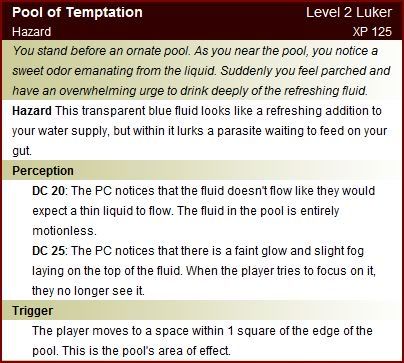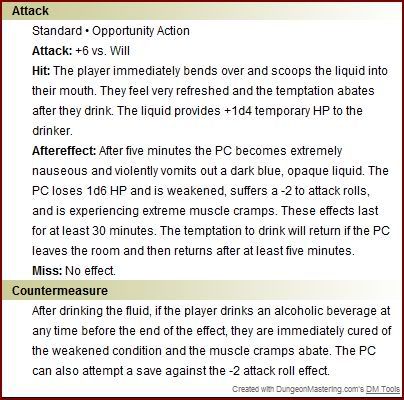One of the things that the developers did in 4e Dnd that I wasn’t sure I would like (or have an easy time adjusting to) was the change in saving throw mechanics. I know there has been a lot of discussion regarding these changes, but I think it is important enough conceptually that I need to address it – plus, it comes up in game so often that it is worth talking about.
Previous Save Mechanic:
It used to be that saving throws represented your defensive qualities and they allowed you make a modified dice roll to determine if you suffer the effects of an attack. A simple example is if a PC was attacked by a creature that had a poison bite, then the player would have to make a saving throw against poison in order to avoid or reduce the effects of the poison. This would include rolling a d20 and then adding the PC’s Base Save Bonus (determined at character creation) + the PC’s ability modifier. If that modified roll was greater than the difficulty class of the designated attack, then the PC made the save. For example, if a centipede’s poison attack had a DC of 11 then the PC would have to roll a d20 and add his base fortitude value and his constitution modifier to the roll; if the result was better than 11, then he saved against the effects of the poison and therefore was not affected.
The way this mechanic worked, a stronger creature could have an effect with a much larger DC than a smaller or weaker creature – thus allowing the ability to scale an effect and have it match the PC’s abilities such that they are appropriately challenged. Having your players face the right challenge level is very important and probably the subject of a future post of its own.
Current Save Mechanic:
That’s how saving throws used to work and how they work in 4e is a bit different. Each PC still has values called Fortitude, Reflex, and Will. These are also still modified by enhancements from powers and equipment and also the PC’s level. It is at this point that two differences come into play…
Fortitude, Reflex, and Will are now considered and treated as true defenses, not saving throws. That is, instead of an abstract concept called a saving throw that seems like a special ability that comes into play only during special circumstances and includes a dice roll by the player, these defenses are meant to represent the PC’s intrinsic physical or mental ability to avoid the effects of particular attacks.
This doesn’t sound extremely different from how it used to be, so let me spell out the difference: these three values are now treated like defenses, just as armor class is treated – in other words, it is a value that the creatures in the game attack, rather than a value that the player adds to a roll in order to fend off an attack. So fortitude acts as a true defense and is a relatively static number. As well the other three defenses (armor class, will, and reflex. That means that these values can cause a creature, when attacking, to miss the PC. These values do not reflect the ability of the PC to fend off or recover from an effect after the PC has already been exposed.
Here’s an example of how these defenses are used: Two players enter a room and see an elevated pool filled with a bluish transparent liquid. As they get closer to the pool (within 1 square) they feel an overwhelming temptation to drink from the pool. As a DM, the way this runs is that I roll an attack vs will on the players that enter the area of effect. If the attack roll is greater than or equal to the PC’s will, then the attack is a hit and I proceed to tell the PC what happens. In this case, they give in to temptation and drink the liquid; at first feeling refreshed and then getting violently ill. Here is what this item may look like if found in an adventure or rulebook:
Thanks to Dungeonmastering.com for the awesome tool I used to make the above image. Go to their website, register, and use them as the great resource that they are!!
So if fortitude, reflex, and will are now true defenses, what happened to saving throws? What do they do and how do you determine what you have to roll?
Well, the developers made the mechanics of saving throws eternally easier in 4e. Any time a PC is faced with an attack that does some sort of special ongoing damage and the attack hits, then the player is affected each round after the hit. Well, let me be specific here, the player takes the ongoing damage at the beginning of her turn and gets a chance to save against the ongoing effects at the end of her turn each round. The saving throw is meant to represent the PC’s intrinsic ability to fight off the condition once it has been exposed. This is different from the defenses (AC, Fort, Ref, Will) because they defend against the initial attack and a saving throw represents the recovery once hit.
But how do you determine what you need to roll to save against the effects?
This is where it is simple: roll a 10 or higher on a d20. Yes, it’s that basic. And it favors the players – PCs have a better than 50% chance to make their save and end the effects of the condition (actual chance = 55%). So saving throws are now part of a vastly easier mechanic because the way a PC saves against every condition in the game is exactly the same (except death, which is a big topic for a future post).
So what is it that I don’t like?
1. I was concerned that the 10 or greater rule would make it too easy for the players to get rid of conditions. At first thought it seems like rolling 10 is pretty easy to do, which bothered me as a DM because it would make ongoing effects pretty useless.
2. I was afraid it would homogenize the idea of ongoing conditions and players and DMs alike would tend to ignore them. In other words, they would all get grouped into the the “oh, I only need a 10, it’s no big deal” camp, setting up a situation that dulls the player’s mindset to the idea of saving throws.
3. I was concerned that saving throws and effects could not be scaled up or down since they all have the same target save value.
Now that I have played in, and DMed, several different sessions with different gaming groups I can say that I am no longer afraid of those things. It just isn’t the case that players too easily escape ongoing conditions. In fact, in the last three sessions in which I have been involved, the players have failed their saves more than half the time. Granted, this is a small sample size, but it was enough to set my DM mind at ease regarding #1 above. Showing #1 to be false is also a strong indication that #2 is not going to be an issue, so I relaxed my view of that issue.
After planning my first 4e encounter, I quickly realized that the target save value doesn’t affect the scaling ability of encounters. Whether or not a PC is affected by a condition depends upon whether or not the PC was hit with an attack. Whether or not a creature’s attack causes an ongoing condition affects the power of it’s attacks and how formidable an opponent it will be – that is the purview of monster design. Choosing whether or not to include a creature in an encounter is the purview of adventure planning. My point is that the scaling happens at the encounter planning and/or monster design stage, not in the middle of a gaming session, and that is how scaling has always been done so my concern in that area is unwarranted.
In practice, the saving throw mechanic is easy and takes the heat off the DM and puts it on the players. How? Well, if the DM makes it the player’s responsibility to track their own PC’s conditions and remember to attempt their saves at the end of their turn, then the DM doesn’t really have to worry about it. This is not really as cut and dried as it sounds, especially with new players or when people are learning a new system, but it does work pretty well. I happen to have an excellent memory and try to help and make sure my players remember their saves, but it is something that I don’t have to spend a huge amount of time documenting and tracking, which is a great boon to me and improves the ease of running my gaming sessions.
What do you think? Was it difficult for you to adjust to the new saving throw mechanic? As a player, do you find it too easy or too difficult to make your saves – or just right?
Until my next post, I wish you good gaming.
~DM Samuel



Hi DM Samuel,
Thanks for the excellent article. You expressed the same concerns I had, which evaporated the moment I actually played the game.
“Come on, how hard is it going to be to roll a 10 or higher?” Trust me, from both sides of the screen, it’s just about impossible.
Thanks for the comment… Yeah, it was amazing how often so many of my players rolled 8 and 9 when they attempted their saves.
It also alleviated my other concern, which was: “oh geez, 5 points, big whoop! Who cares about 5 little HP when they’ve got 67” Failing that save so often makes that little 5 point ongoing damage really detrimental when they roll an 8, a 4, and a 2 and take that damage for 4 rounds – suddenly that little attack did 20 points!
A lot of it comes down to save boosting/save penalties in my opinion. Nowadays, there’s a lot of ways to help an ally’s saving throw, so crucial saves will typically have some bonuses. So the chance of it being just 50/50 nowadays are less. However, enemies also have certain ways to impose penalties (as do players also). So that swings the pendulum again.
I agree. I think I am in an interesting situation with one of my groups because, so far, my players haven’t exploited very many powers that improve the chances of a successful saving throw. I think they may also suffer from the “it’s easy to roll a 10 or better” misconception, which sits in the back of their minds when they choose powers, and so they end up without those bonuses.
On the other hand, not having any bonuses to the saving throws against death creates a lot of tension when you are the one making your third roll after two fails… it’s interesting to watch that d20 roll across the table and then see the emotional reaction to the result, no matter what it is. THAT is exciting gaming.